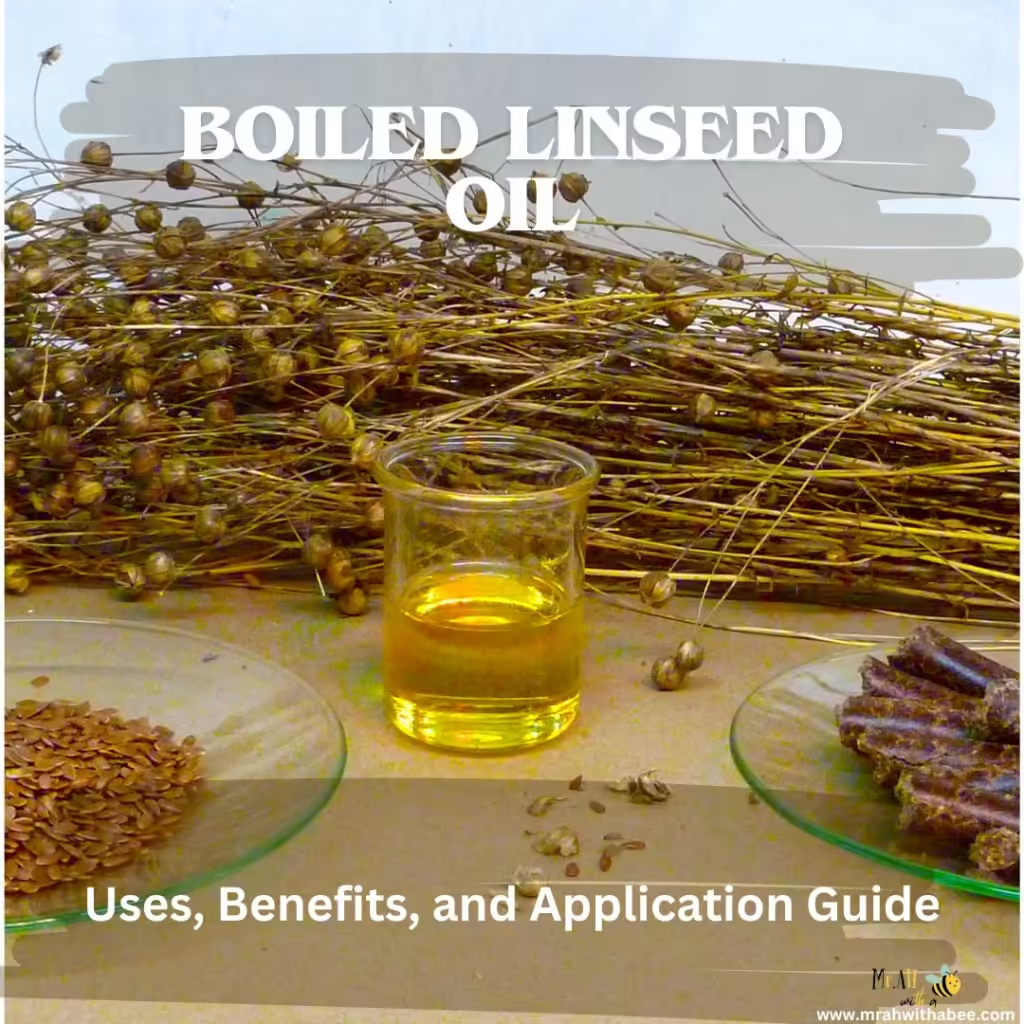Linseed oil is derived from flax seeds which have a long history of use as a natural wood preservative. A modified version of Boiled Linseed Oil (BLO), is a famous finishing oil for wood and metal, known for its long-lasting and drying time. Let’s delve into what makes it unique, its application, and the best ways to use it.
What is Boiled Linseed Oil?
Benefits of Boiled Linseed Oil
Boiled linseed oil offers several advantages:
- Faster Drying Time: BLO is treated with heat and sometimes additives like metallic drying agents (Cobalt, zinc, and manganese), by absorbing oxygen from the air and transferring it to the oil, which speeds up the drying process. Where quick application and finishing are the key factors, this faster drying time makes it an ideal choice for time-sensitive projects.
- Enhanced Penetration in Wood: One of the best features of boiled linseed oil is soaking it into the wood’s cellulosic grain and fibers strengthening the wood and protecting it from scratches, nicks, and watermarks. BLO helps to block moisture damage, warping, and cracking by filling out the pores and fibers by ensuring the longevity of wooden items.
- Improved Finish and Durability: Boiled linseed oil makes a beautiful, rich finish that enhances the natural grain of the wood. This makes it a famous choice for furniture, cabinetry, and decorative items, as its glossy appearance promotes depth and warmth to the surface. Additionally, BLO provides durable protective layers that guard against scratches, stains, and environmental factors. By ensuring that wooden items remain attractive and well-preserved over time, this combination of beauty and durability makes boiled linseed oil an excellent choice for both functional and decorative wood surfaces,
Common Uses of Boiled Linseed Oil
Boiled linseed oil is versatile, and commonly used for:
Wood Finishing and Protection:
BLO creates a quality finish on woods and antiques, providing a water-resistant finish, that is ideal for interior and exterior wooden surfaces. It absorbs deeply into the woods to improve the flow, durability, and leveling of oil-based paints. This brings out the natural tones and grain patterns, making it particularly suitable for outdoor furniture, decking, and other structures exposed to the elements. It also helps to protect it from mold, and mildew growth, contributing to the longevity of the finish. Ensuring that wooden surfaces remain attractive and functional over time, creates a warm, inviting look while offering protection against spills and everyday wear for indoor applications.
Paint and Varnish Additive:
Adding BLO to paints and varnishes can remarkably improve their performance. It enhances the flexibility of the paint by allowing the paint to expand and contract with temperature changes without cracking. Additionally, the oil enhances adhesion to the surface, resulting in a smoother application and a more durable finish. Boiled linseed oil can also be used to create a hard, glossy finish when mixed with pigments; however, it’s important to consider the oil’s acid number and its compatibility with the pigment. By using BLO as an additive, homeowners and professionals can achieve a longer-lasting and more resilient coating for their projects.
Garden Tool and Outdoor Furniture Preservation:
For garden tools and outdoor furniture that are made of metal and wood, BLO is an effective preservative. When applied, it helps protect the furniture from rust and weathering, thereby extending the lifespan of these items. It creates a protective film that protects them from their exposure to moisture and corrosion, ensuring the good-condition and functionality of metal tools. The oil acts as a barrier against the wooden outdoor furniture, preventing damage from rain, sun, and humidity. Additionally, you can use boiled linseed oil as a sealant for terracotta tiles and stone flooring, making it a valuable addition to any maintenance routine for homeowners and gardeners.
How to Apply Boiled Linseed Oil
To apply BLO effectively:
- Surface Preparation: It’s important to ensure that the surface is clean and properly sanded before applying boiled linseed oil. Remove any dust, dirt, or old finishes that may interfere with the oil’s absorption. Use fine-grit sandpaper to create a smooth surface, allowing the oil to absorb effectively. For achieving a uniform finish and enhancing the overall appearance of the wood, this preparation step is important.
- Application Technique: When applying BLO, use a clean cloth or a brush to spread a thin coat evenly over the surface. Working in the direction of the wood grain ensures better penetration and a smoother finish. Apply the oil generously but avoid over-saturation to prevent stickiness. Allow 15 to 30 minutes for soaking before wiping off excess.
- Drying Time: Allow BLO to dry completely between coats, usually taking 24 hours. Ensure the surface is dry before applying additional coats. As multiple thin layers will provide better protection than a single thick coat, this waiting period is crucial for achieving the desired depth of finish and durability. Boiled linseed oil contains metal siccatives, such as cobalt and manganese, which shorten the drying time.
Safety Considerations
When using BLO, keep these safety tips in mind:
- Flammability: Rags soaked in oil can pose a risk of spontaneous combustion. To prevent this, store them in a sealed metal container or submerge them in water.
- Ventilation: Apply boiled linseed oil in a well-ventilated area to prevent inhaling any fumes.
- Disposal: Properly dispose of used rags and leftover oil.
Boiled Linseed Oil vs. Other Finishing Oils
Compared to other oils like tung oil and mineral oil:
- BLO vs. Tung Oil: Tung oil dries harder but is more expensive and takes longer to apply.
- BLO vs. Mineral Oil: Mineral oil doesn’t dry and is safer for food applications, whereas BLO is best for creating durable wood finishes.
Conclusion
BLO is a versatile, durable option for preserving wood and metal surfaces. It offers a rich finish and enhanced durability, making it a great choice for DIY enthusiasts and professionals alike. Consider using BLO for your next wood-finishing project, and follow proper application techniques and safety precautions for optimal results.
FAQ
- Can BLO seal concrete?
Yes, it can help seal concrete, providing a protective layer against moisture, but it may require frequent reapplication. - Can you add BLO to latex paint?
No, BLO is oil-based and does not mix well with latex paint, which is water-based. - BLO and turpentine – what’s the connection?
Turpentine thins BLO, making it easier to apply and improving penetration on surfaces. - What type of finish does BLO give?
BLO provides a rich, warm finish, enhancing the wood grain with a semi-gloss sheen.
Thank you for reading, for more interesting articles visit our homepage.



